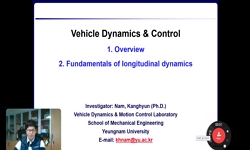본 연구에서는 전원장치 냉각시스템과 히트펌프의 결합을 통해 상변화물질 적용에 따른 전기자동차의 냉각에너지 소비량과 주행에너지 변화를 분석하였다. 실험 데이터를 기반으로 히트펌...
http://chineseinput.net/에서 pinyin(병음)방식으로 중국어를 변환할 수 있습니다.
변환된 중국어를 복사하여 사용하시면 됩니다.
- 中文 을 입력하시려면 zhongwen을 입력하시고 space를누르시면됩니다.
- 北京 을 입력하시려면 beijing을 입력하시고 space를 누르시면 됩니다.
Performance analysis of thermal management system for fuel cell/battery hybrid electric vehicle applied with phase change material
한글로보기부가정보
국문 초록 (Abstract)
상변화물질 적용에 따른 전기자동차의 냉각에너지 소비량과 주행에너지
변화를 분석하였다. 실험 데이터를 기반으로 히트펌프와 상변화물질을
이용한 차량 열관리시스템(VTMS)을 개발하였으며, 차량의 외부 형상정보
및 동력전달 효율을 반영하여 전원부의 전기적 부하에 따른 발열을
모델링하였다. 검증된 모델을 기반으로 상변화물질이 적용된 VTMS 의
성능을 상변화물질의 질량, 차량 속도 및 외기 온도의 세 가지 관점에서
평가하였다. 결과적으로 상변화물질 100 kg 을 적용하였을 때 기존 시스템
대비 구동에 필요한 에너지는 약 2.68% 증가하는 한편, 열관리에 필요한
에너지는 약 39% 감소하여 총 에너지 소비량이 약 3.8% 감소하였다.
또한, 비주행상황에서 압축기 작동 없이 상변화물질에 저장된 냉방
에너지만으로 캐빈 냉방이 가능한 것을 확인하였다.
본 연구에서는 전원장치 냉각시스템과 히트펌프의 결합을 통해
상변화물질 적용에 따른 전기자동차의 냉각에너지 소비량과 주행에너지
변화를 분석하였다. 실험 데이터를 기반으로 히트펌프와 상변화물질을
이용한 차량 열관리시스템(VTMS)을 개발하였으며, 차량의 외부 형상정보
및 동력전달 효율을 반영하여 전원부의 전기적 부하에 따른 발열을
모델링하였다. 검증된 모델을 기반으로 상변화물질이 적용된 VTMS 의
성능을 상변화물질의 질량, 차량 속도 및 외기 온도의 세 가지 관점에서
평가하였다. 결과적으로 상변화물질 100 kg 을 적용하였을 때 기존 시스템
대비 구동에 필요한 에너지는 약 2.68% 증가하는 한편, 열관리에 필요한
에너지는 약 39% 감소하여 총 에너지 소비량이 약 3.8% 감소하였다.
또한, 비주행상황에서 압축기 작동 없이 상변화물질에 저장된 냉방
에너지만으로 캐빈 냉방이 가능한 것을 확인하였다.
다국어 초록 (Multilingual Abstract)
electric vehicles according to the application of phase change materials were
analyzed via integration of power source cooling system and heat pump. The
vehicle thermal management system (VTMS) with heat pump and phase
change material was developed based on the experimental data, and the heat
generation according to the electrical load of power source was modeled by ii
reflecting the exterior and power transmission efficiency of the vehicle. On
the basis of the validated model, VTMS with phase change material was
comprehensively evaluated from the standpoint of three critical factors: phase
change material weight, vehicle velocity and ambient temperature.
Consequently, when 100 kg of phase change material was applied, the energy
required for driving increased by about 2.68% and the energy required for
thermal management decreased by about 39% compared to the baseline,
reducing the total energy consumption by about 3.8%. In addition, it was
confirmed whether cabin cooling was possible only with thermal energy
storage system without compressor work in a non-traveling situation.
In this study, the cooling energy consumption and driving energy variation of electric vehicles according to the application of phase change materials were analyzed via integration of power source cooling system and heat pump. The vehicle thermal m...
In this study, the cooling energy consumption and driving energy variation of
electric vehicles according to the application of phase change materials were
analyzed via integration of power source cooling system and heat pump. The
vehicle thermal management system (VTMS) with heat pump and phase
change material was developed based on the experimental data, and the heat
generation according to the electrical load of power source was modeled by ii
reflecting the exterior and power transmission efficiency of the vehicle. On
the basis of the validated model, VTMS with phase change material was
comprehensively evaluated from the standpoint of three critical factors: phase
change material weight, vehicle velocity and ambient temperature.
Consequently, when 100 kg of phase change material was applied, the energy
required for driving increased by about 2.68% and the energy required for
thermal management decreased by about 39% compared to the baseline,
reducing the total energy consumption by about 3.8%. In addition, it was
confirmed whether cabin cooling was possible only with thermal energy
storage system without compressor work in a non-traveling situation.
목차 (Table of Contents)
- Contents
- Chapter 1. Introduction .............................................................. 1
- 1.1 Background............................................................................................ 1
- 1.2 Literature review of vehicle thermal management strategies........... 3
- 1.3 Research objectives............................................................................... 6
- Contents
- Chapter 1. Introduction .............................................................. 1
- 1.1 Background............................................................................................ 1
- 1.2 Literature review of vehicle thermal management strategies........... 3
- 1.3 Research objectives............................................................................... 6
- Chapter 2. System description.................................................... 7
- 2.1 Baseline thermal management system ................................................ 7
- 2.2 PCM vehicle thermal management system........................................11
- Chapter 3. Simulation model development............................. 13
- 3.1 Power demand modeling .................................................................... 13
- 3.2 Heat generation model........................................................................ 21
- 3.2.1 Fuel cell heat generation model ......................................... 21
- 3.2.2 Battery heat generation model........................................... 24
- 3.3 VTMS modeling .................................................................................. 28
- 3.4 Simulation modeling ........................................................................... 37
- Chapter 4. Simulation results and discussions ....................... 40
- 4.1 Transient performance with driving cycle........................................ 40
- 4.2 Effect of VTMS with PCM................................................................. 44
- 4.3 Effect of ambient temperature........................................................... 53
- 4.4 Cabin cooling performance ................................................................ 58
- Chapter 5. Conclusions ............................................................. 63
- Reference










